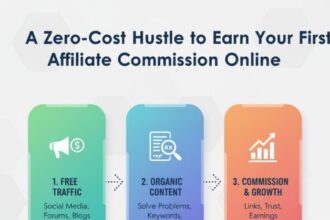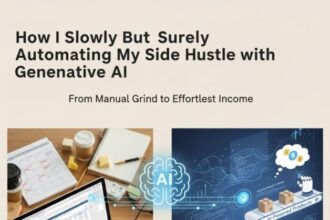(SEO Title: My Accidental Deep Dive into No Deposit Online Money Making Strategies (and What Actually Worked
The clock on my microwave blinked 2:17 AM in angry red numbers. And there I was, bathed in the blue light of my phone, scrolling. Just scrolling. My heart was doing this weird little tap dance against my ribs, the kind it only does when a surprise car repair bill decides to show up at the worst possible time. You know the feeling, right?
I wasn’t doomscrolling the news or stalking an ex on social media. No, my search history was a desperate, chaotic mess. I was frantically Googling every possible version of no deposit online money making strategies I could think of.
It felt like shouting into a void.
Every click led to another flashy landing page with a stock photo of someone laughing on a laptop at the beach. Every article promised the world but seemed to demand my credit card number for an “exclusive startup kit” first. It was a paradox that was making my head spin. How can you make money with no money if you have to spend money to start?
Honestly, I felt like a fool. I was tired, stressed, and on the verge of just giving up and accepting that my bank account was going to take a serious hit.
But I didn’t.
Instead, I fell down one of the deepest, weirdest, and ultimately most useful rabbit holes of my entire life. And this is the story of what I found at the bottom. It’s not a get-rich-quick scheme. It’s just… what I learned. My journey from 2 AM panic to having a few real, practical ways to bring in a little extra cash. No deposit required. For real this time.
My First Steps Into the Wild, Weird World of Making Money from Your Couch
So, my journey didn’t start with a brilliant plan. It started with pure, unfiltered confusion. The internet, when you ask it how to make money, is like the world’s biggest, loudest, and most disorganized library. Everyone is shouting, and half the books are written in a language you don’t understand.
I was drowning in a sea of options that all sounded vaguely plausible but also… a little bit sketchy. Affiliate marketing? Drop-shipping? Crypto airdrops? I didn’t even know what those things meant, let alone how to start doing them without accidentally signing my life away.
Basically, I felt like I needed a degree just to understand the tutorials that were supposed to help me. It was beyond frustrating.
Drowning in Jargon
My first attempts were a complete mess. I’d read a blog post that would get me all excited about a specific idea. For example, one of the first things I latched onto was the idea to get paid to write online for free. It sounded simple enough. I know how to write. I got decent grades in English. How hard could it be?
Turns out, pretty hard. At least, when you don’t know where to look.
I’d find sites that wanted me to write 500-word articles for five dollars. I did the math. Even if I could magically write a perfect article in an hour, that was less than minimum wage. It felt exploitative. Other sites were “content mills” that seemed to value speed over quality, and the thought of churning out robotic, soulless content just made me feel… empty.
It wasn’t about making a living wage at this point. I just wanted to find something legitimate that valued a person’s actual time and effort. Something that didn’t feel like a digital dead end.
The First Platforms I Tried (and Failed With)
This led me to what I thought was the next logical step: freelance platforms without investment. You know the big ones. The sites that act as a middleman between people who need work done and people who can do the work.
My first impression? Utter chaos.
Signing up for one of these platforms felt like walking into a massive, global flea market for the very first time. There are thousands of stalls, everyone is shouting about what they’re selling, and you have no idea how to tell the quality goods from the junk.
That was me. I was the person with a little foldable table and a handwritten sign that just said, “I can do stuff!” while a thousand other people had professional banners, flashing lights, and a long list of five-star reviews. I’d see jobs posted, but dozens, sometimes hundreds, of people would bid on them within minutes. How could I possibly compete?
I sent out a few proposals into the digital ether. They were met with a deafening silence. It was demoralizing. I was trying to solve a money problem, but I felt like I was just wasting my most valuable resource: time. It felt like trying to get a job by shouting your resume into a hurricane. Pointless.
I was ready to give up. I figured the whole “online money” thing was a myth for regular people like me. It was for tech bros, marketing gurus, or people who already had a massive online following. But then, something shifted. It started when I began to question the very things I thought were true.
Turns Out, a Lot of People Are Wrong About No Deposit Online Money Making Strategies
After the initial flameout, I took a step back. I stopped searching for a few days and started thinking. Why was this so hard? What was I missing? It occurred to me that maybe my entire approach was wrong. Maybe I was buying into a bunch of myths without even realizing it.
This is a really important part of my story, I think. Because I had to unlearn a lot of garbage before I could learn anything useful.
So, I decided to tackle these myths head-on. To really examine the promises I was seeing everywhere and ask myself, “Is that really how it works?”
Misconception #1: The Idea That It’s ‘Easy’ or ‘Passive’
This is the biggest, most tempting lie of them all. You see it everywhere. “Make money while you sleep!” “Earn passive income with this one weird trick!” It’s plastered all over YouTube thumbnails and sketchy ads.
But here’s the thing I learned: there is no such thing as truly passive income, at least not at the beginning. It’s a total myth.
Behind every “passive” income stream is a mountain of active, upfront work. The person making money from their blog? They spent years writing, editing, and learning SEO. The YouTuber with millions of views? They invested hundreds of hours in filming, scripting, and editing. The person selling an online course? They spent months developing the curriculum and building a reputation.
It’s not passive. It’s leveraged. They did the work once, and now they are reaping the rewards over and over.
For someone like me, starting from zero, the idea of “passive income” was a dangerous distraction. It made me look for shortcuts that didn’t exist. The moment I accepted that this was going to be active work—just work I could do from my couch—my perspective changed completely. It stopped being a lottery ticket and started being a job, even if it was just for a few hours a week.
Misconception #2: The Belief That Online Surveys Are a Goldmine
Okay, let’s talk about the elephant in the room. Online surveys. They are often the very first thing people encounter when they look for ways to make money online for free. They seem so simple, so harmless. Just click a few buttons, share your opinion, and watch the pennies roll in.
So, are online surveys a waste of time?
From my personal, non-scientific, and slightly bitter experience… mostly, yes.
I signed up for a handful of the most popular survey sites. The first problem was the screening process. I’d spend ten minutes answering preliminary questions only to be told, “Sorry, you are not a fit for this survey.” That’s ten minutes of my life gone, with zero compensation. It happened over and over again.
When I did qualify, the payout was… let’s just say, underwhelming. I once spent a solid 25 minutes carefully answering questions about my breakfast cereal preferences, for which I was rewarded with 40 cents. I did the math again. That works out to less than a dollar an hour. I could make more money collecting loose change from my sofa cushions.
Now, am I saying it’s impossible to make money? No. You can make a few bucks. But the time investment is, in my opinion, astronomical for the return you get. The “gig economy” can be a tough place. In fact, a study from the Pew Research Center on the gig economy highlights that while many people participate, the income is often supplemental and inconsistent. It’s not a path to financial stability for most.
For me, surveys were a time sink that offered the illusion of productivity. I was clicking, but I wasn’t earning.
Misconception #3: The Biggest Lie of All
The biggest lie, the one that underpins all the others, is that you need to find a secret website or a magic system. This belief is what fuels the entire industry of gurus selling courses and “blueprints.” They want you to believe that there’s a locked door and they are selling the only key.
But there is no secret website. There is no magic system.
This was a tough pill to swallow because it meant there was no easy answer. But it was also incredibly freeing. If there was no secret key, then I didn’t need to buy one. I didn’t need to keep searching for that one “miracle” site that would solve all my problems.
It meant that the solution wasn’t external. It wasn’t “out there” somewhere on the internet.
It was already with me.
This realization, this debunking of the myths I had unconsciously absorbed, was the turning point. It cleared out all the noise and allowed me to finally hear the one simple idea that would change everything.
The One Simple Idea That Finally Made This Whole Thing Click
So there I was, sitting in a pile of my own failed attempts and debunked myths. I had tried the content mills. I had tried the chaotic freelance platforms. I had tried the soul-crushing surveys. Nothing worked.
I felt like I was back at square one, but it was actually a much better place. It was a clean slate.
The “Aha!” moment didn’t come in a flash of lightning. It was quieter. It was a slow-dawning realization that grew out of one simple question: “What if I’m starting in the wrong place?”
The Wrong Way I Was Looking at It
My entire approach had been backward.
I was starting with the question, “What websites will pay me money?” This led me to all the traps: the surveys, the low-paying content mills, the platforms where I was just a nameless, faceless beginner. I was trying to fit myself into the shape of the opportunities I found.
It was like going to a hardware store and asking, “What can I build with this random screw I found on the floor?” It’s a nonsensical way to approach a project.
You’re supposed to decide what you want to build first, and then go find the right tools and materials.
This was it. This was the fundamental shift. I had to stop looking for the magic website and start looking at myself.
Shifting My Perspective
The new question became: “What skills do I already have that someone might be willing to pay for?”
Suddenly, the whole game changed. I wasn’t looking for a task to do anymore. I was looking for a problem I could solve for someone else, even a small one. It was all about monetizing a skill I already have. That phrase became my new mantra.
It sounds so simple, right? Almost insultingly obvious. But when you’re in that panic-scrolling mode, it’s anything but.
I realized my “product” wasn’t my time; it was my ability. It was a complete mental reversal. Instead of being a passive task-doer waiting for a platform to give me work, I could be an active service-provider looking for a client.
It’s like I had been wandering through a forest, starving, looking for a vending machine that dispensed fish. My “aha!” moment was realizing I already had the ability to weave a net. I just needed to identify the materials I had on hand and find the right stream to cast it in.
This shift is the core of everything. If you’re struggling as I was, I genuinely encourage you to stop and think about this. You might even want to check out this other post I’ve been thinking about, called [Finding Your Hidden Talents to Build Your Side Hustle], because it’s amazing what you’ll find when you actually look.
Once I started thinking this way, the path forward became infinitely clearer. It was time to stop searching and start building my own tiny, unofficial, no-nonsense system.
My Personal, No-Nonsense Guide to Actually Trying These No Deposit Online Money Making Strategies
Alright, so this is the part you’re probably here for. What do I actually do now? How did I go from confusion to consistently making a little bit of extra, no-strings-attached money every month?
First, a disclaimer. This is not a “system” in the guru sense. There’s nothing to buy. It’s just my personal, cobbled-together process. It’s what works for me, a regular person with a regular life and no special “expert” skills. It’s built on that core idea of leveraging what I already have.
This is my blueprint, built on trial and a whole lot of error.
1. My First Step: An Honest and Brutal Skill Audit
Before I even opened my laptop again, I took out a piece of paper and a pen. I know, old school. At the top, I wrote, “Things I’m Decently Good At.”
I forced myself to be brutally honest and incredibly simple. This wasn’t a resume. I wasn’t trying to impress anyone.
My list looked something like this:
I can type pretty fast and accurately.
I have a good grasp of English grammar and spelling. I notice typos in restaurant menus.
I’m generally good at following a detailed set of instructions.
I have a decent eye for things that look “off” or “clunky” on a website.
I can express my opinion clearly.
That’s it. No “synergistic process optimization” or corporate jargon. Just simple, human skills. This list became my compass. Any opportunity I looked at from this point forward had to align with one of these things. No more trying to become a day trader or a graphic designer overnight.
2. The First Real Strategy: Becoming a Digital “Mystery Shopper”
Remember my list? The part about having a good eye for things that look “clunky” and being able to express my opinion clearly? This led me straight to the world of user testing websites for beginners.
And this, my friend, was a game-changer.
What is it? Basically, companies, from small startups to huge corporations, need real people to test their websites and apps. They want to know: Is our site confusing? Is this button hard to find? What do you think of our checkout process? They pay you to use their site, speak your thoughts out loud, and answer a few questions.
How it works: You sign up for a user testing platform. I started with a very reputable one like UserTesting.com. You fill out your profile, and then you take a practice test to show you can follow directions and articulate your thoughts.
Once you’re approved, you’ll see a dashboard of available tests. Each test tells you what device you need (computer, phone), what they’re looking for (e.g., “someone who shops for clothes online”), and how much it pays. A typical test takes 15-20 minutes and, in my experience, pays around $10.
Suddenly, the math worked. That’s a potential rate of $30 an hour. A world of difference from the 40-cent surveys.
This was the first time I felt like I had found a legitimate exchange of value. I was providing a genuinely helpful service (my honest feedback) and being compensated fairly for my time and attention. It perfectly matched the skills on my list.
3. Filling the Gaps: The World of Microtasks
User testing is great, but it’s not always consistent. You might get three tests in one day and then none for the next two. So, I needed something to fill the gaps. Something I could do for 5 or 10 minutes when I was waiting for a meeting to start or had a little downtime.
This led me to paid microtasks online.
The idea here is to do tiny, human-intelligence tasks that computers are still bad at. Think things like: transcribing a 30-second audio clip, identifying objects in an image for AI training, or checking a business’s website to see if their phone number is correct.
The big player: The most well-known platform for this is Amazon Mechanical Turk (mTurk). It’s a bit of a learning curve, I won’t lie. The interface looks like it was designed in 2005. But once you get the hang of it, you can find reputable “requesters” who post thousands of these tiny tasks, often paying a few cents each.
My take: This is not going to make you rich. Not even close. But it’s also not trying to. I use it as a digital piggy bank. If I have a spare 15 minutes, I can knock out a few tasks and make a dollar or two. It adds up. It’s a much, much better use of that “dead time” than scrolling through social media. And unlike surveys, you’re almost always accepted for the task, and the work is very direct.
4. Putting It All Together in a Flexible Routine
So, here’s what my “system” looks like in practice. It’s not a rigid schedule. It’s a flexible menu of options based on how much time and energy I have.
Primary Focus: I check for user tests first. They have the best return on my time. I aim to do a few of these each week. That’s my main goal.
Secondary Task: When there are no tests, or I have a solid block of 30-60 minutes, I might look for simple transcription or proofreading tasks. These use the skills from my list and pay better than microtasks.
Filler Activity: When I only have a few minutes, I’ll log into mTurk and do a few quick hits. It’s my “instead of Instagram” activity.
This combination is what finally worked. It’s a blend of higher-paying, less frequent work (user testing) and lower-paying, always-available work (microtasks). It doesn’t rely on any single source. It’s my own little diversified portfolio of effort.
And best of all, every single part of it started with that simple list of skills. It’s the foundation for what I consider [Building a Sustainable Side Hustle], one that actually fits into your real life.
So, Where Does That Leave Me?
Remember that person from the introduction? The one staring at their phone at 2 AM, heart pounding with anxiety?
I’m happy to say, I’m not that person anymore.
Not because I’m now rich and retired on a beach somewhere. Far from it. That surprise car repair bill still hurt. But the feeling is different now. The panic has been replaced by a quiet confidence. The desperation has been replaced by a plan.
The biggest thing I gained from this whole rabbit hole wasn’t the extra hundred or two hundred bucks a month, though that is definitely nice. The biggest thing I gained was a sense of agency. A sense of control.
I learned that the internet isn’t just a place to be sold to. It’s a place where you can provide real value, even on a small scale.
I proved to myself that no deposit online money making strategies aren’t a myth. They just don’t look like what the gurus tell you. They look like work. They look like introspection. They look like leveraging the small, quiet skills you’ve had all along.
The journey was messy and full of wrong turns. But I came out the other side with a practical toolkit and a totally new perspective. I’m no longer searching for the magic key. I’m just focused on getting better at weaving my own nets.
And I guess that leaves me with just one final question for you.
What hidden skill are you sitting on right now, just waiting to be noticed?





































